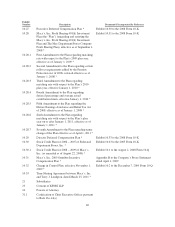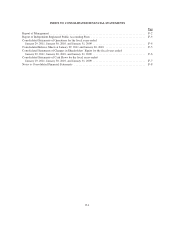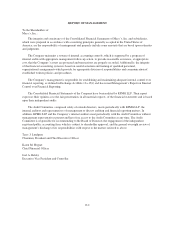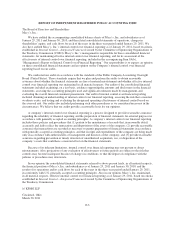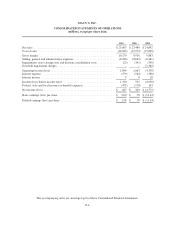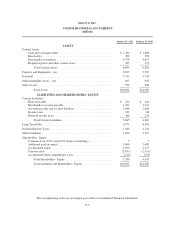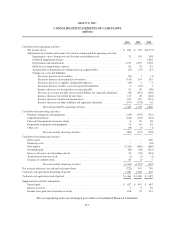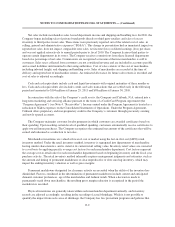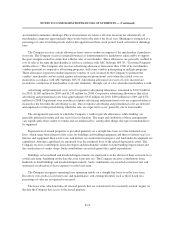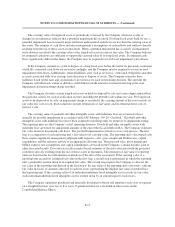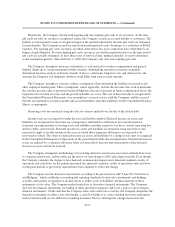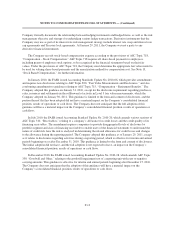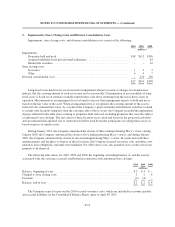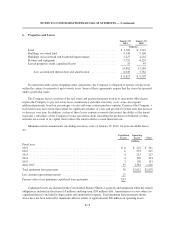Macy's 2010 Annual Report Download - page 56
Download and view the complete annual report
Please find page 56 of the 2010 Macy's annual report below. You can navigate through the pages in the report by either clicking on the pages listed below, or by using the keyword search tool below to find specific information within the annual report.
MACY’S, INC.
NOTES TO CONSOLIDATED FINANCIAL STATEMENTS
1. Organization and Summary of Significant Accounting Policies
Macy’s, Inc. and subsidiaries (the “Company”) is a retail organization operating retail stores and Internet
websites under two brands (Macy’s and Bloomingdale’s) that sell a wide range of merchandise, including men’s,
women’s and children’s apparel and accessories, cosmetics, home furnishings and other consumer goods in 45
states, the District of Columbia, Guam and Puerto Rico. As of January 29, 2011, the Company’s operations were
conducted through Macy’s, macys.com, Bloomingdale’s, bloomingdales.com and Bloomingdale’s Outlet, which
are aggregated into one reporting segment in accordance with the Financial Accounting Standards Board
(“FASB”) Accounting Standards Codification (“ASC”) Topic 280, “Segment Reporting.” The metrics used by
management to assess the performance of the Company’s operating divisions include sales trends, gross margin
rates, expense rates, and rates of earnings before interest and taxes (“EBIT”) and earnings before interest, taxes,
depreciation and amortization (“EBITDA”). The Company’s operating divisions have historically had similar
economic characteristics and are expected to have similar economic characteristics and long-term financial
performance in future periods.
For 2010, 2009 and 2008, the following merchandise constituted the following percentages of sales:
2010 2009 2008
Feminine Accessories, Intimate Apparel, Shoes and Cosmetics ......................... 36% 36% 36%
Feminine Apparel ............................................................. 26 26 27
Men’s and Children’s .......................................................... 23 22 22
Home/Miscellaneous .......................................................... 15 16 15
100% 100% 100%
The Company’s fiscal year ends on the Saturday closest to January 31. Fiscal years 2010, 2009 and 2008
ended on January 29, 2011, January 30, 2010 and January 31, 2009, respectively. References to years in the
Consolidated Financial Statements relate to fiscal years rather than calendar years.
The Consolidated Financial Statements include the accounts of the Company and its wholly-owned
subsidiaries. The Company from time to time invests in companies engaged in complementary businesses.
Investments in companies in which the Company has the ability to exercise significant influence, but not control,
are accounted for by the equity method. All marketable equity and debt securities held by the Company are
accounted for under ASC Topic 320, “Investments – Debt and Equity Securities,” with unrealized gains and
losses on available-for-sale securities being included as a separate component of accumulated other
comprehensive income, net of income tax effect. All other investments are carried at cost. All significant
intercompany transactions have been eliminated.
The preparation of financial statements in conformity with accounting principles generally accepted in the
United States of America requires management to make estimates and assumptions that affect the reported
amounts of assets and liabilities and disclosure of contingent assets and liabilities at the date of the financial
statements and the reported amounts of revenues and expenses during the reporting period. Such estimates and
assumptions are subject to inherent uncertainties, which may result in actual amounts differing from reported
amounts.
Certain reclassifications were made to prior years’ amounts to conform with the classifications of such
amounts for the most recent year.
F-8


